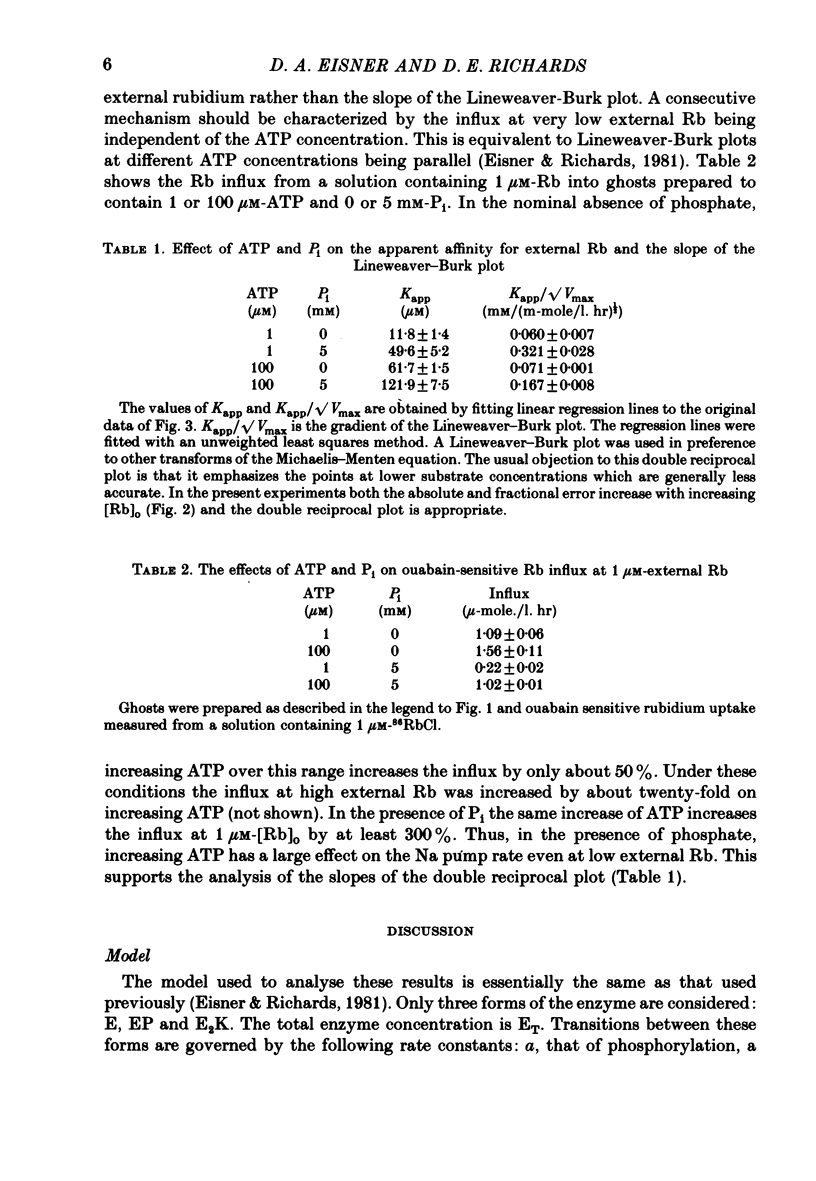Abstract
1. Ouabain-sensitive Rb influx was measured into K-free resealed red cell ghosts. The effects of inorganic phosphate (Pi) were examined. 2. Phosphate decreased the magnitude of the influx. Increasing Pi lowered the apparent affinity for both ATP and external rubidium ions. The effects of Pi on the affinity for external Rb were greatest at low ATP concentrations. 3. In the nominal absence of phosphate, increasing ATP from 1 to 100 microM had little effect on the Rb influx from solutions of low (1 microM) rubidium concentrations. In the presence of Pi, ATP increased Rb uptake markedly, even from solutions of low Rb concentration. 4. The above interactions between Pi, ATP and external Rb are consistent with a consecutive scheme for the Na pump in which phosphate is released after potassium binds at the external surface and before ATP binds to release potassium ions to the internal solution. 5. Previous failures to find an effect of phosphate on either the affinity for ATP or that for external potassium (rubidium) ions are shown to be equally consistent with the model. The lack of change of apparent affinity is shown to result from the restricted range of concentrations used in these previous experiments.
Full text
PDF









Selected References
These references are in PubMed. This may not be the complete list of references from this article.
- Beaugé L. A., Glynn I. M. Occlusion of K ions in the unphosphorylated sodium pump. Nature. 1979 Aug 9;280(5722):510–512. doi: 10.1038/280510a0. [DOI] [PubMed] [Google Scholar]
- Chipperfield A. R., Whittam R. Evidence that ATP is hydrolysed in a one-step reaction of the sodium pump. Proc R Soc Lond B Biol Sci. 1974 Nov 5;187(1088):269–280. doi: 10.1098/rspb.1974.0074. [DOI] [PubMed] [Google Scholar]
- Garay R. P., Garrahan P. J. The interaction of adenosinetriphosphate and inorganic phosphate with the sodium pump in red cells. J Physiol. 1975 Jul;249(1):51–67. doi: 10.1113/jphysiol.1975.sp011002. [DOI] [PMC free article] [PubMed] [Google Scholar]
- Garrahan P. J., Glynn I. M. The behaviour of the sodium pump in red cells in the absence of external potassium. J Physiol. 1967 Sep;192(1):159–174. doi: 10.1113/jphysiol.1967.sp008294. [DOI] [PMC free article] [PubMed] [Google Scholar]
- Glynn I. M., Karlish S. J. ATP hydrolysis associated with an uncoupled sodium flux through the sodium pump: evidence for allosteric effects of intracellular ATP and extracellular sodium. J Physiol. 1976 Apr;256(2):465–496. doi: 10.1113/jphysiol.1976.sp011333. [DOI] [PMC free article] [PubMed] [Google Scholar]
- Glynn I. M., Lew V. L., Lüthi U. Reversal of the potassium entry mechanism in red cells, with and without reversal of the entire pump cycle. J Physiol. 1970 Apr;207(2):371–391. doi: 10.1113/jphysiol.1970.sp009067. [DOI] [PMC free article] [PubMed] [Google Scholar]
- Hegyvary C., Post R. L. Binding of adenosine triphosphate to sodium and potassium ion-stimulated adenosine triphosphatase. J Biol Chem. 1971 Sep 10;246(17):5234–5240. [PubMed] [Google Scholar]
- Hexum T., Samson F. E., Jr, Himes R. H. Kinetic studies of membrane (Na+-K+-Mg2+)-ATPase. Biochim Biophys Acta. 1970 Aug 15;212(2):322–331. doi: 10.1016/0005-2744(70)90213-5. [DOI] [PubMed] [Google Scholar]
- Karlish S. J., Yates D. W., Glynn I. M. Conformational transitions between Na+-bound and K+-bound forms of (Na+ + K+)-ATPase, studied with formycin nucleotides. Biochim Biophys Acta. 1978 Jul 7;525(1):252–264. doi: 10.1016/0005-2744(78)90219-x. [DOI] [PubMed] [Google Scholar]
- Karlish S. J., Yates D. W. Tryptophan fluorescence of (Na+ + K+)-ATPase as a tool for study of the enzyme mechanism. Biochim Biophys Acta. 1978 Nov 10;527(1):115–130. doi: 10.1016/0005-2744(78)90261-9. [DOI] [PubMed] [Google Scholar]
- NODA L., NIHEI T., MORALES M. F. The enzymatic activity and inhibition of adenosine 5'-triphosphate-creatine transphosphorylase. J Biol Chem. 1960 Oct;235:2830–2834. [PubMed] [Google Scholar]
- Post R. L., Hegyvary C., Kume S. Activation by adenosine triphosphate in the phosphorylation kinetics of sodium and potassium ion transport adenosine triphosphatase. J Biol Chem. 1972 Oct 25;247(20):6530–6540. [PubMed] [Google Scholar]
- Post R. L., Toda G., Rogers F. N. Phosphorylation by inorganic phosphate of sodium plus potassium ion transport adenosine triphosphatase. Four reactive states. J Biol Chem. 1975 Jan 25;250(2):691–701. [PubMed] [Google Scholar]
- Robinson J. D., Flashner M. S., Marin G. K. Inhibition of the (Na+ + K+)-dependent ATPase by inorganic phosphate. Biochim Biophys Acta. 1978 Jun 2;509(3):419–428. doi: 10.1016/0005-2736(78)90236-5. [DOI] [PubMed] [Google Scholar]
- Sachs J. R. Kinetic evaluation of the Na-K pump reaction mechanism. J Physiol. 1977 Dec;273(2):489–514. doi: 10.1113/jphysiol.1977.sp012106. [DOI] [PMC free article] [PubMed] [Google Scholar]
- Sachs J. R. The order of release of sodium and addition of potassium in the sodium-potassium pump reaction mechanism. J Physiol. 1980 May;302:219–240. doi: 10.1113/jphysiol.1980.sp013239. [DOI] [PMC free article] [PubMed] [Google Scholar]


